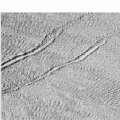Newfoundland: Trawling
Fishing is a large part of the culture in Newfoundland and Labrador (NL) and has been ongoing for hundreds of years. A common fish harvesting technique used within the province is otter trawling, which is used to catch different species such as Cod, Shrimp, American Plaice and Yellowtail.
In general, trawling requires fish to enter the mouth of a cone shaped net that retains the desired species in the tail portion known as the cod end. A trawl consists of many components, most of which do not come in contact with the seafloor. However, over the past several years there has been debate around the trawling industry and its effects on benthic habitats. This debate is mostly attributed to the trawl components that are in contact with the seabed, namely the doors (otter boards) and footgear. Otter boards are typically constructed of steel and used to spread the trawl and, to a certain degree, herd fish. The footgear consists of either rubber discs or bobbins that protect the trawl from getting snagged on the ocean bottom.
 Although not fully understood, trawling can reduce the structural complexity of the seafloor, and that can have serious consequences for many species of invertebrates and fishes. The effects on an area, if any, are dependent on fish biology, natural disturbance (currents, tides, storms, etc.), substrate type (sand, gravel, rock, etc.) and fishing intensity. Intensity and persistence of trawling is usually indicated by the presence of trawl scour marks caused by the doors and/or footgear. On this expedition in Newfoundland and Labrador waters, the R/V Endeavor has encountered numerous trawl markings.
Although not fully understood, trawling can reduce the structural complexity of the seafloor, and that can have serious consequences for many species of invertebrates and fishes. The effects on an area, if any, are dependent on fish biology, natural disturbance (currents, tides, storms, etc.), substrate type (sand, gravel, rock, etc.) and fishing intensity. Intensity and persistence of trawling is usually indicated by the presence of trawl scour marks caused by the doors and/or footgear. On this expedition in Newfoundland and Labrador waters, the R/V Endeavor has encountered numerous trawl markings.
Currently, marine researchers are utilizing acoustic seabed mapping technologies for determining the effects of the trawling fishery. Tools such as sidescan sonar (SSS) and multibeam echo sounders (MBES) transmit acoustic energy in the shape of a fan that sweeps the seafloor from directly under the vessel, towfish or autonomous underwater vehicle (AUV). The resulting seafloor images can be used to identify substrate type and relief from trawl doors, footgear, or other fishing techniques such as dredging. Both sidescan and multibeam acoustics are valuable tools used in fisheries research on grounds such as the Grand Banks off Newfoundland. Technologies such as these make it possible for scientists and managers to reduce seabed impacts resulting from fishing and help sustain a healthy ocean environment.